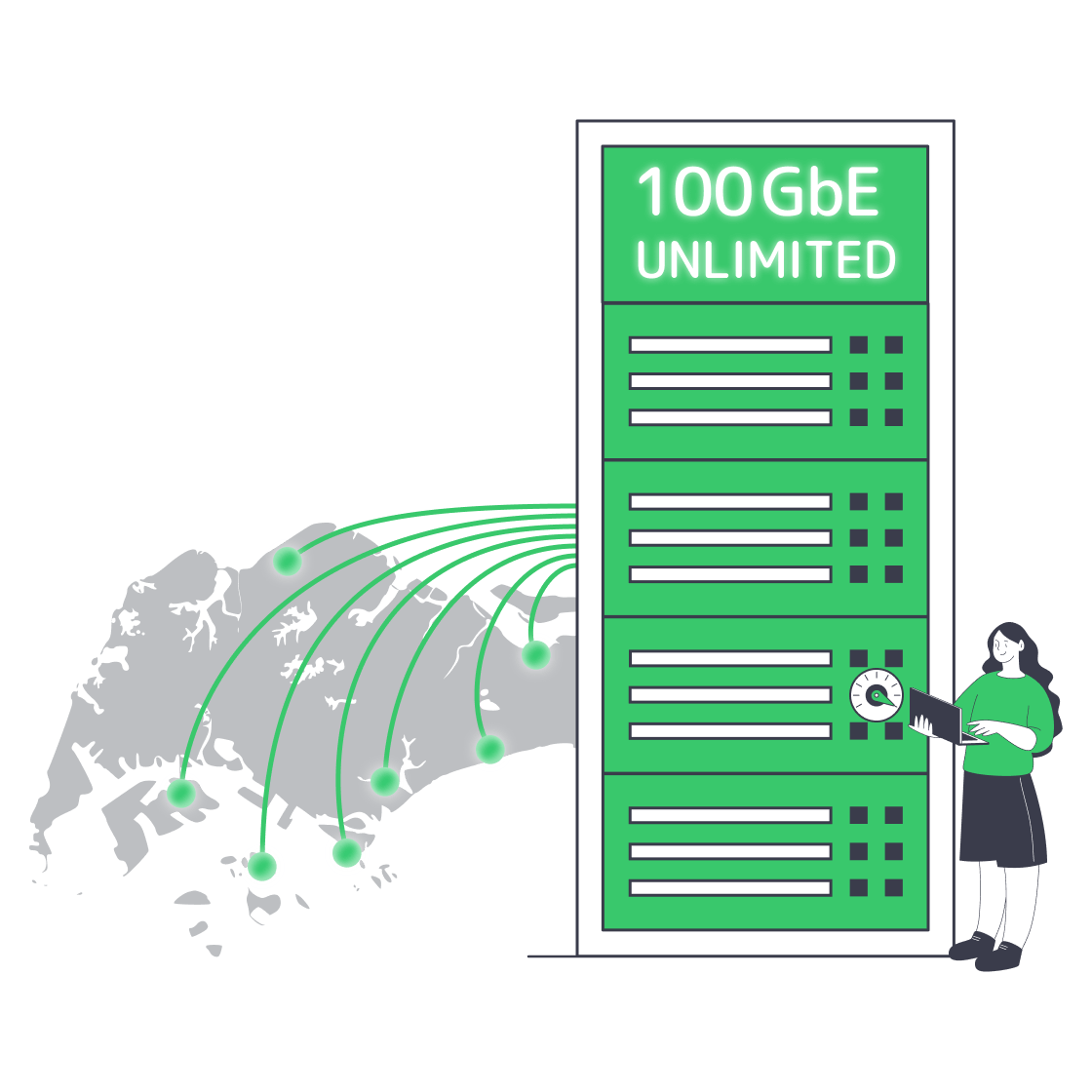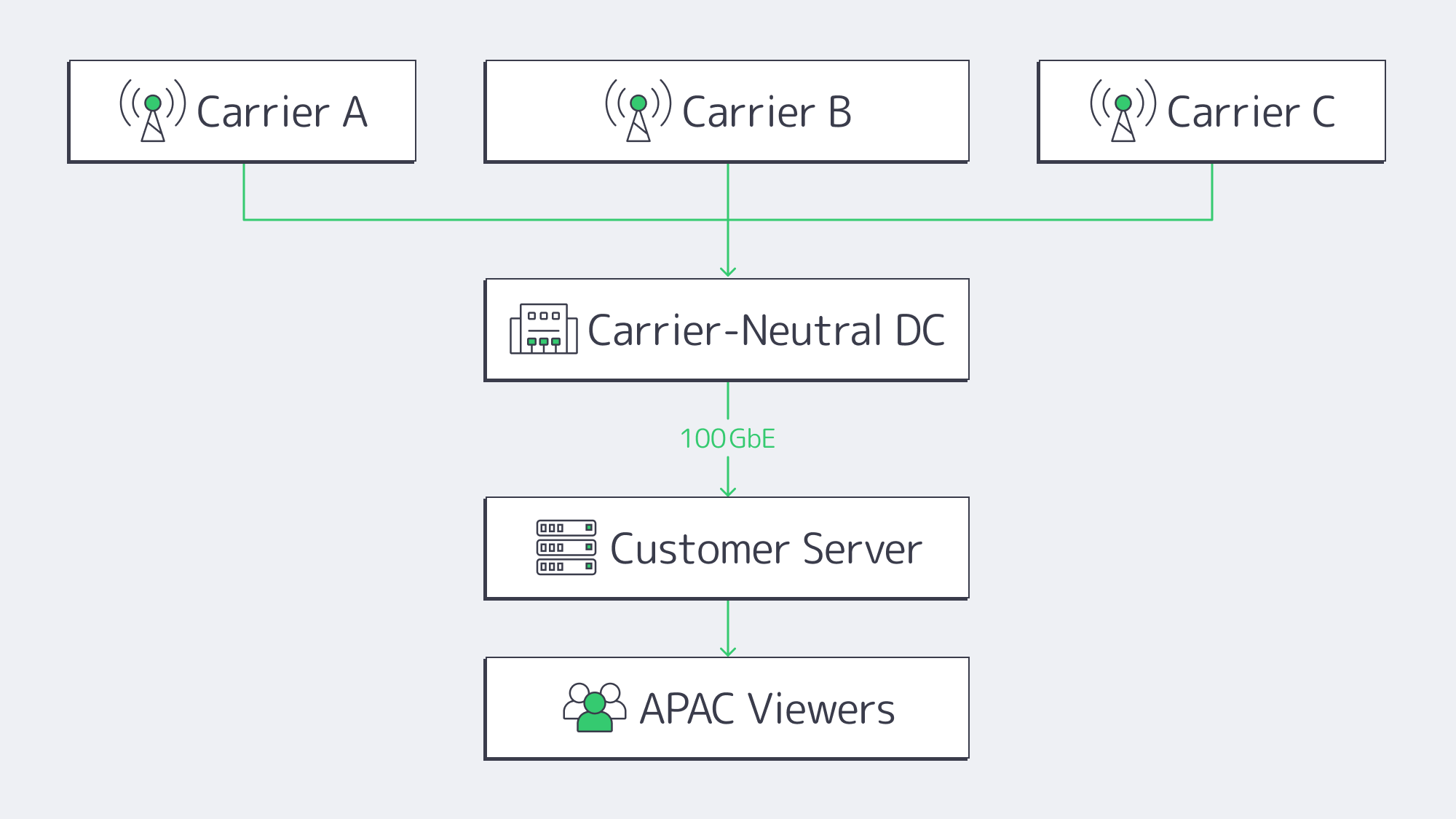Blog

Find Truly Unlimited Bandwidth Servers in Singapore
Singapore’s strategic perch on Asian fiber routes—combined with a steady decline in wholesale IP-transit rates—has turned unmetered dedicated servers from niche luxury to a mainstream option. There are over 70 carrier-neutral data centers in the area that handle 1.4 GW of installed IT load within the city-state’s 728 km² boundaries. In addition to the infrastructure, regulators have already approved another 300 MW of “green” capacity, so the dense interconnectivity on offer will only grow. This expanding supply and cheaper costs mean that hosts can bundle sizeable, flat-priced ports for mainstream use that previously wouldn’t have been economically viable.[1]
Choose Melbicom— 400+ ready-to-go servers configs — Tier III-certified SG data center — Unmetered bandwidth plans |
 |
These unlimited offers are particularly attractive for buyers dealing in petabytes. Those who stream high-bit-rate videos, for example, are expected to make up roughly 82 percent of all consumer internet traffic this year, according to Cisco.[2] However, “unlimited” might not be as unlimited as it seems on the surface. Many deals still conceal the limits, making it hard to understand what you’re getting. We have compiled a quick guide to help you understand what to audit, measure, and demand when you are in the market for a cheap dedicated Singapore server that needs to work around the clock, flat out.
How to Read an “Unlimited Bandwidth” Offer on Servers
Fair-Use Clauses, TB Figures, and Wiggle Words
First off, be sure to look for fair use triggers in the terms of service. You will likely find something along the lines of “We reserve the right to cap after N PB.” If you deal with large traffic and a limit exists, it should be hundreds of terabytes per Gbps, or removed entirely.
Avoid 95th-Percentile “Bursts”
Some providers disguise the illegitimacy of their unlimited plans through the 95th-percentile billing model. You might find 1 Gbps advertised, but with a guarantee of 250 Mbps sustained; however, should you exceed the percentile threshold, the link becomes throttled or billed at overage rates, which can be costly. These “burst” plans often come from big brands and are being heavily criticized by communities. They essentially drop speeds as soon as the average use climbs.[3] When scanning the documentation, look for words like “burst,” “peak,” “commit,” or specific percentile formulas. If the port is truly unlimited, it will stay unmetered and simply state the speed transparently.
No-Ratio Guarantees and Transparency
If the port is oversubscribed, then “unmetered” is irrelevant. Ideally, you need dedicated capacities with no contention ratios, which means that the full line rate you purchase is solely yours. Marketing claims should be verifiable by looking at real-time graphs with measurable metrics, so that your teams can see the throughput matches. At Melbicom, we are dedicated to providing sole servers with no-ratio guarantees for our clients.
Which Infrastructure Signals Prove a Truly Unlimited Server?

Carrier-Neutral Data Centers
It is wise to prioritize hosts located in carrier-neutral Tier III+ data centers.
- Singapore’s Equinix SG
- Global Switch
- Digital Realty
- SIN1 facilities
Choosing multiple on-net carriers over single-carrier buildings that rely on one upstream prevents the likelihood of silent limits being imposed on heavy users during peaks, ensuring a plentiful upstream capacity and competitive transit rates.
Recent Fiber and Peering Expansion
There are 26 active submarine cable systems in Singapore, and two new Trans-Pacific routes (Bifrost (≃10 Tbps design) and Echo) that land directly on America’s West Coast are scheduled this year to help bypass regional bottlenecks.[5] This will inevitably bring massive headroom for hosts to honor their promises of unmetered server connections.
Port Availability Options
If the vendor has a range of ports available, then it is an infrastructural signal that its back-end capacity can meet unlimited needs. When there are 10 Gbps, 40 Gbps, or 100 Gbps configurations ready to spin up today, you are in good hands. With Melbicom, you can have a Singapore server at 1 to 200 Gbps. Though the upper end may be far more than you need, knowing that you can commit to 1 Gbps with provisions of 100 GbE available gives you the peace of mind that you won’t be oversold gigabit uplinks for your traffic.
How Can You Prove an “Unlimited” Port Is Truly Unlimited?
| Port speed | Max monthly transfer @ 100 % load | Rough equivalence |
|---|---|---|
| 1 Gbps | 330 TB | ≈63 M HD movies |
| 10 Gbps | 3.3 PB | ≈630 M HD movies |
| 100 Gbps | 33 PB | ≈6.3 B HD movies |
Tip: You should be able to move ~330 TB/mo. of any “unmetered 1 Gbps” without incurring any sort of penalty. If there is less stated within the fine print, then it isn’t truly unlimited.
Test what you buy.
- Looking-glass probes – be sure to check multiple continents when you pull vendor sample files. Melbicom’s Singapore facility downloads hover near line rate from well-peered locations.
- Iperf3 marathons – Run Iperf sessions at or near full port speed for at least 6 hours to spot any sudden drops that indicate hidden shaping.
- Peak-hour spot checks – To help detect oversubscription, you can saturate the link during APAC prime time; collective loads shouldn’t decrease with a capable network.
- Packet-loss watch – If a server is truly unlimited, then packet loss should be below 0.5 % during traffic spikes.
The above test will expose any inconsistencies. If discovered, you can invoke the SLA and have the hosts troubleshoot or expand capacity. Reputable hosts that are committed to delivering the throughput that they market should credit your bill.
Why Is “Unlimited Bandwidth” Offer Everywhere Now?

An unmetered 1 Gbps port in Singapore would have set you back roughly US$3,000 per month, minimum, around a decade ago. Bandwidth was once bought wholesale and imposed sky-high 95th-percentile rates. They also rationed it through small TB quotas, making it far less viable for smaller businesses. These days, bulk 100 GbE transit is available for a tenth of the cost, and the prices are continuing to drop as competition and content-provider-funded cables increase in the area.[4]
- Netflix, Meta, and TikTok now have regional caches located within Singapore IXPs, keeping outbound traffic local and avoiding costly subsea hops.
- The Digital Connectivity Blueprint policy that Singapore’s government has put in place links new cables and “green” data-center capacity directly to GDP growth. This speeds up regulatory processes when it comes to network expansion.
- Hosts such as Melbicom have multiple 100 GbE uplinks that span continents. Working at such a scale means adding one more unmetered customer barely affects the commit.
The evolutions mentioned above mean that streaming platforms and other high-traffic clients can get an Asia plan for a dedicated server that rivals European or U.S. pricing without moving away from end-users in Jakarta or Tokyo.
How to Choose an Unlimited-Bandwidth Dedicated Server in Singapore
- Scrutinize the contract. Make sure there are no references to 95th %, burst percentages. If “fair use” is mentioned without revealing the numbers, then steer clear.
- Vet the facility. Prioritize Tier III, carrier-neutral buildings with published lists that can be checked.
- Look for a 100 GbE roadmap. Although you might only need 10 Gbps for now, a roadmap indicates that the provider is a future-proof option.
- Prove and verify marketing spiel and service agreement details. Download test files, run lengthy Iperf tests, and review port graphs.
- Historical context checks. More established hosts could be carrying over outdated caps whereas the raw throughput capabilities provided by modern fiber often means that newer entrants can beat them.
If you can tick the above criteria you have a better chance of having found an authentic, always-on, “unlimited” full-speed dedicated Singapore server.
Why Singapore Is Ready for Truly Unlimited Dedicated Servers

The bandwidth economics in Singapore have evolved: transit is cheaper, budgets are climbing in data centers, and new Terabit-scale cables are on the horizon. It is now possible to obtain the bandwidth needed in Singapore for platforms with demanding, continuous, high-bit-rate traffic affordably and provably without hidden constraints. That is, if you know what to look for!
When just about everybody boasts “unlimited” services and uses jargon to confuse the matter, it can be tougher to separate the smoke from the substance. However, armed with our advice, you should be able to weed out the genuine deals. The upside is that you can quickly separate smoke from substance by checking fair-use language, validating that the data center is carrier-neutral, looking for 100 GbE readiness, and benchmarking sustained throughput against published MSAs.
Order your server
Spin up an unmetered dedicated server in Singapore with guaranteed no-ratio bandwidth.